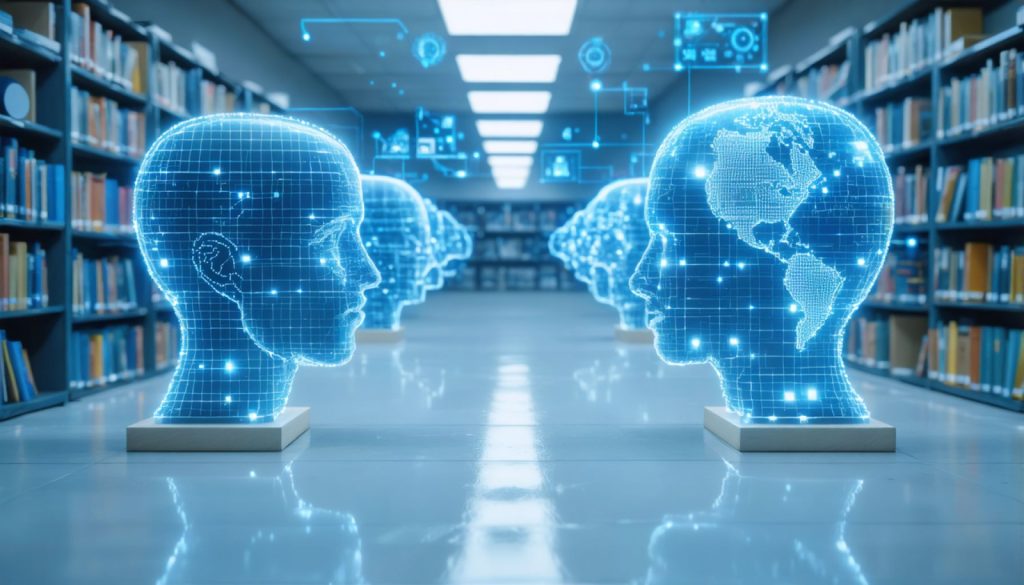
- AI is transforming education, enhancing capabilities rather than replacing jobs, raising questions of equitable benefit.
- Elite institutions like Lower Merion School District and Haverford College actively integrate AI to enhance learning and ethical usage.
- There is a stark divide between privileged schools using AI and underfunded schools with limited access to technology.
- Innovative tools like AI-assisted Khanmigo aim to democratize learning but face challenges without equitable support.
- The U.S. Department of Education acknowledges AI’s potential, urging equitable implementation to ensure wide-reaching benefits.
- The overarching goal is equitable access to AI in education, empowering students across all demographics.
- Policymakers and technologists must work to ensure AI adoption benefits all students, not just a privileged few.
The relentless march of technology promises a future where artificial intelligence reshapes the very fabric of education, bringing with it profound opportunities—and equally stark challenges. At its core, this transformation raises a pressing question: Who benefits when AI enters the classroom? As AI assumes a role less about replacing jobs and more about enhancing capabilities, the answer may well define the future.
At the pinnacle of privileged education, institutions like Lower Merion School District in Pennsylvania have already embraced AI as a pivotal partner in learning. Here, AI is not just a tool but a co-educator, shaping young minds to navigate a world in which technology guides discovery. In these hallowed halls, AI is the advisor suggesting improvements, the mentor in ethical usage, and the catalyst for deeper inquiry.
Not far away, Haverford College has pioneered an AI integration that begins even before students set foot on campus. Their admissions process now openly incorporates AI, encouraging applicants to utilize these advanced tools intelligently and responsibly. This foresight paves the way for future leaders adept at leveraging technology while remaining critically aware of its ethical dimensions. Led by tech-savvy visionaries, Haverford’s initiatives position them at the forefront of a necessary revolution in digital literacy.
Yet, this tale of progress has its counterpoint in underfunded schools, where students’ access to AI is sparse, if present at all. Here, outdated equipment and the absence of structured AI initiatives mark a striking contrast. In these environments, the promise of AI-enhanced learning remains elusive, a distant beacon in a landscape muddied by inequity.
The consequences of this divide are deeply felt. Innovative AI-assisted tools—envisioned to bridge knowledge gaps—thrive where resources and training abound but falter in the absence of such support. For students in these less-advantaged districts, AI becomes a ghost—seen, perhaps heard of, but unreachable.
Encouragingly, luminaries such as Sal Khan of Khan Academy understand the stakes. Through initiatives like Khanmigo, a digital tutor built on AI, Khan seeks to democratize learning, promising personalized guidance irrespective of geography. His vision is clear: a world where learning is equitably accelerated by AI-driven insights. Yet Khan, too, warns of the dangers; without proper oversight, AI tools risk becoming just another ephemeral promise in the world of educational technology.
On the broader national stage, the U.S. Department of Education has recognized the transformative potential of AI, releasing reports to inspire immediate action. But action must be met with implementation, and implementation with equity. Until systemic changes occur, the AI advantage will remain a privilege of the few, rather than a right of the many.
The lesson is stark and unmissable—AI in education is about more than just integrating technology; it’s about shaping a future where every student, regardless of their zip code, has the roadmap to a technologically enriched world. For educators, policymakers, and technologists alike, the task is not just to welcome AI, but to ensure its embrace uplifts everyone.
How AI is Revolutionizing Education: Who Truly Benefits and How to Ensure It Helps All
The Future of AI in Education: Enhancing Opportunities and Addressing Challenges
Artificial intelligence is rapidly transforming educational landscapes, offering unprecedented opportunities for personalized learning, efficiency, and engagement. However, as AI becomes an integral part of classrooms, key questions arise: Who truly benefits from this technological evolution, and how can we ensure equitable access to these advancements?
The Advancements and Opportunities of AI in Education
AI as a Co-Educator:
AI technology enhances traditional teaching methods by acting as a co-educator, assisting students in personalized learning paths. For instance, institutions like the Lower Merion School District are utilizing AI to guide students in their learning journeys, providing tools that suggest improvements and foster inquiry.
Admissions and AI:
Beyond classroom learning, AI is revolutionizing the admissions process. Haverford College sets a precedent by incorporating AI into their admissions strategies, encouraging applicants to utilize and understand AI technologies responsibly.
AI in Underprivileged Areas:
Contrastingly, the integration of AI in education highlights a digital divide. Many underfunded schools grapple with outdated equipment and limited AI access, creating significant obstacles for students. This technological gap can widen educational inequalities, affecting future opportunities for many students.
How AI Can Be Integrated Effectively Across All Districts
Encouraging Equity:
To ensure AI benefits all, it’s crucial to focus on equity in access and implementation. Non-profit organizations like Khan Academy are making strides to level the playing field through AI-powered tools like Khanmigo, aiming to provide personalized education to all students regardless of their location.
Government and Policy Involvement:
The U.S. Department of Education recognizes AI’s potential and stresses the importance of equitable implementation. Their reports advocate for immediate actions to integrate AI into curricula, emphasizing the need for educational systems that provide equal opportunities for all students.
Pressing Questions and Expert Insights
Can AI Replace Teachers?
While AI enhances learning, it cannot replace the human element that teachers bring to the classroom. Teachers play a vital role in social and emotional development, critical thinking, and mentorship, areas where AI is unable to contribute fully.
What are the Limitations of AI in Education?
AI systems require significant data and training to function effectively. Concerns about data privacy, bias, and over-reliance remain. These limitations call for a balanced approach where AI supplements, rather than takes over, traditional educational methods.
How to Ensure Ethical Use of AI in Education?
Adopting ethical AI practices involves transparency, accountability, and inclusivity. Schools must adapt responsible AI policies, train educators, and develop curricula that emphasize ethical AI usage.
Actionable Recommendations and Tips
How to Get Started with AI in Education:
1. Invest in Training: Schools should provide AI training for educators to ensure effective implementation.
2. Assess Infrastructure: Evaluate and upgrade technological infrastructure to support AI tools.
3. Foster Partnerships: Collaborate with tech companies and non-profits to facilitate access to AI resources.
4. Implement Responsible Policies: Develop clear policies around data use and ethical AI applications.
5. Promote Community Involvement: Engage parents and local community organizations to support AI initiatives.
AI has the potential to transform education profoundly, but with these advancements comes the responsibility to ensure these changes benefit everyone. By prioritizing equity in AI access, fostering responsible usages, and supporting educators, we can create a future where AI enhances learning for all students.
For more innovative approaches to learning, check out Khan Academy and explore how to integrate advanced tech in education.



